Around the Neighborhood - Volume 2, Number 1
In 1973, Family Communications initiated a print newsletter titled Around the Neighborhood. This newspaper-like publication was largely directed towards parents but included some material for children as well. The information below documents the first issue from Volume 2 of Around the Neighborhood.
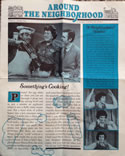
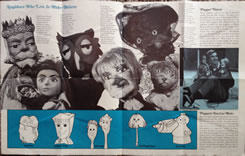
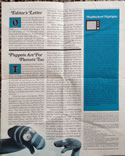
[click images for larger view]
Articles Included:
- Something's Cooking!
- A Neighborhood Visitor
- Neighbors Who Live in Make-Believe
- Puppet Voices
- Puppets You Can Make
- Editor's Letter
- Puppets Are For Parents Too
- Neighborhood Highlights
Articles
Presto! An egg white so clear you can see through it plops into the mixing bowl and in just a minute an eggbeater whips it into a fluffy white mountain. Put a hard stick of yellow butter into a hot saucepan and -- chango! it melts into a shiny puddle in the pan. Mixing and heating food makes changes that are fun to see and taste and smell. Hot stoves and heavy pans are for grownups, but there are some things you can "cook" without a stove. You might like to try your own version of Julia Child's Spaghetti Sauce Marco Polo the next time your mother makes some spaghetti or macaroni. Ask her to melt some butter and pour it over the spaghetti. (Some children like to cut up their spaghetti first with scissors.) Then add your own good things to eat. Tuna fish in chunks tastes good. You can crumble American cheese into the spaghetti or sprinkle Parmesan from a can. Spices like oregano, garlic salt or chives taste good too. You might like cutting up small bunches of fresh parsley with scissors -- it looks like a plate full of confetti. Crumpled potato chips can make a crunchy topping. Mrs. Child used black olives, walnuts, and chopped pimiento in her sauce, but you can use what you like to eat right on the spaghetti.
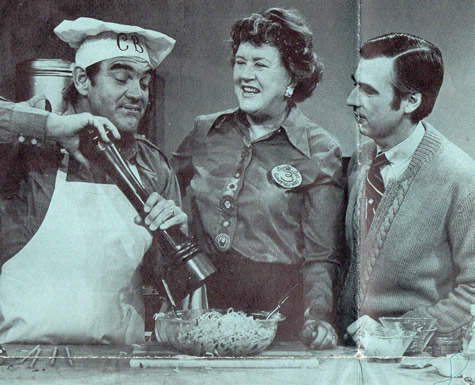
Mr. Rogers meets a new friend in his television neighborhood. Tim Scanlon is an actor, a photographer, and a teacher. Tim knows how to do lots of different things. He talks differently too because he can't hear how his voice sounds. He is deaf so he can't hear other people's voices either. But he can tell what they are saying by watching their lips and acting things out. Words are only one way to express thoughts and feelings. We can tell a lot by watching what hands do and how faces look. When you want to touch or hold something, you may point to it or reach out for it. When you are angry, you may frown or put your hands on your hips. Mr. Scanlon can make motions with his hands. He can use his face to show different feelings.
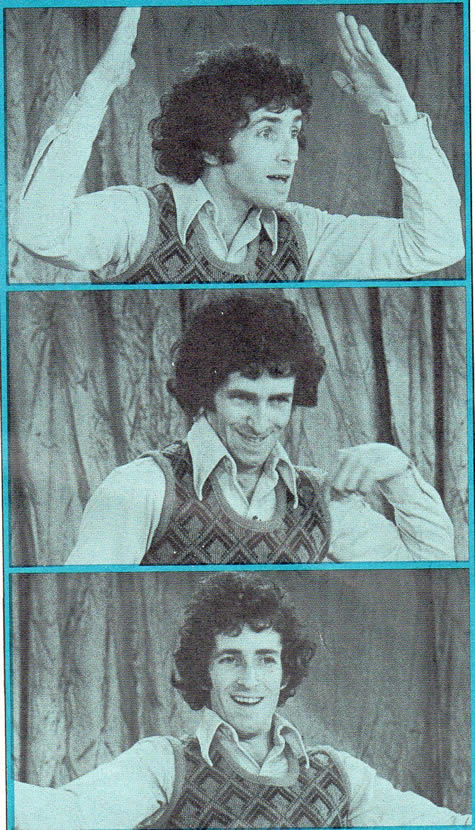
NEIGHBORS WHO LIVE IN MAKE-BELIEVE
King Friday knows how important his job is to the whole neighborhood. He likes to make rules and proclaim things, but he needs the advice of his neighbors too. And he feels good knowing how important he is to Queen Sara and Prince Tuesday.
X the Owl likes to share a joke and help a friend. He admires Ben Franklin and loves learning. Once in a while, X needs time to himself to write poetry and to think. "Nifty galifty!"
Lady Elaine Fairchilde loves music and mischief and all the things she keeps in her Museum-Go-Round. Sometimes she is naughty -- she loves to turn things upside-down with her magical Boomerang Toomerang Soomerang. But she does helpful things with it too. Her mischief is one way of asking for attention and love. "Toot toot, sweetie!"
Henrietta Pussycat is fond of her pretty things. It is sometimes hard for Henrietta to ask for things she really wants. Her friends help her to tell her feelings to understand them. "Meow meow like you."
Daniel Striped Tiger likes being a tame tiger, not a fierce one. Once in a while he wishes he were not so shy. He can learn to love new things and try new ideas if he is allowed to take his time.
Many children write to say that X the Owl sounds just like Mr. Rogers. You may have heard Mr. Rogers' voice in the voices of Henrietta Pussycat and Daniel Tiger too, or some of the other puppets. Mr. Rogers makes the different sounds for the puppets in Make-Believe. He uses a high voice for Daniel and a loud, deep voice for King Friday. Two of his friends help with puppets too -- Bill Barker does the Platypus family and Bob Trow does Harriet Elizabeth Cow. Can you make your voice sound different? What kind of voice would you use for a baby puppet like Prince Tuesday? Or for a small soft kitten puppet? Or a large moose puppet?
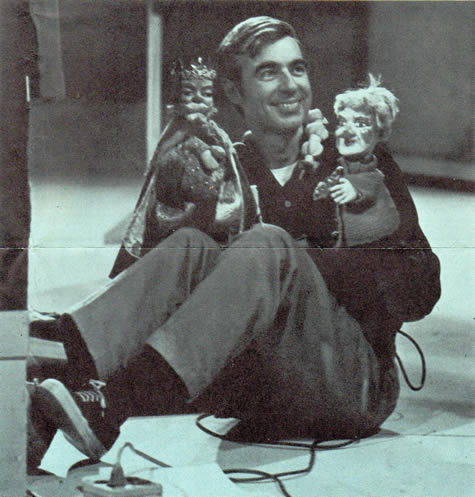
Here are some puppets that people sometimes like to make and play with. If you want button eyes for the mitten puppet, you may need to ask a grownup to sew it for you. You can paste paper eyes on by yourself. You could use old newspapers or magazines, yard, stockings, crayons, and glue to make the paperbag puppets. The spoon puppet's face can be crayoned and its hair or fur pasted on. You might find the dishwasher tool puppet helping with the family dishes. (Some puppets you don't have to make. Some you just find.) Bob and Judy Brown, of the Brown Puppet Theatre, like to make puppets out of detergent and bleach bottles.

One year ago the first issue of Around the Neighborhood was printed. Susan Hitchcock worked to fashion it into the warm, enjoyable family communication Fred Rogers and his staff wanted. For the next nine issues, Susan tailored Around the Neighborhood so that it would come still closer to the interests readers expressed. A questionnaire included in #7 brought a deluge of thoughtful responses, many with personal notes attached. As a result of what we learned through the questionnaire, we have redesigned Around the Neighborhood. The smaller four-page format gives children pages to turn and fits their hands better. There are more articles and crafts printed in large clear type and written for children.
Susan Hitchcock recently resigned the editorship of Around the Neighborhood when she moved to another city. It is sad to lose her fulltime ability and energy, but she will still write some of the articles for us. Our lively concern for children and their families continues, and editorial suggestions are very welcome. We look forward to sharing ideas, feelings, and experiences with you in the coming year. -- Barbara Staib, Editor
The puppets in the Neighborhood of Make-Believe live in curious places like Daniel's clock or Lady Elaine's Museum-Go-Round. Anything can happen in Make-Believe -- King Friday demands a pool of water big enough to waterski on, and he gets one! But Fred Rogers knew that puppets can also express the deep or difficult or brand-new feelings children encounter. Funny characters and songs can help a child recognize his own feelings, and think about them from a safe distance.
Over the years of programs, Make-Believe has become a microcosm inhabited by puppets who act like the real people a child knows. King Friday and Queen Sara are examples of authorities. Daniel Tiger and Henrietta Pussycat are like young children. They have young voices; they are small and sometimes shy. Their relationships and perspectives are like those of the small children who watch them. X the Owl, Lady Elaine, and the others represent many of the characteristics any child's older friends and neighbors might have.
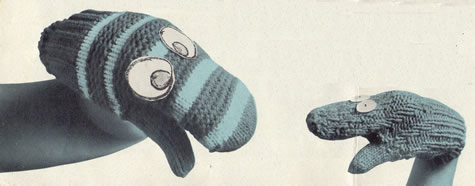
Each puppet has its strengths and weaknesses. Lady Elaine is mischievous, but she is also candid and wise. Each puppet tries hard to overcome its special weakness. King Friday visibly works to overcome his tendency to be unreasonable. With this range of characters to draw on, things happen in Make-Believe much the way they happen in real life. For example, X the Owl is jealous of a pretty bell the King has given to Henrietta for work she has done. X is even more jealous of the work itself. He can't express how jealous and left-out he feels, so he shows it -- he takes the bell away and hides it! Like the children we know, the puppets often find that their first solutions to problems are immature and don't solve anything. They must often ask for help. They need encouragement to tell people in plain words how they feel. Then others can understand their problems and try to show them better ways to deal with it. For instance, King Friday is helped to understand X's feelings and gives him some important work to do too.
Experiences in Make-Believe can help children understand their own. A child who has "walked through" a fear of thunder by watching Daniel Tiger do it may have already gotten a handle on what he feels when the thunder rolls. And the same Make-Believe can help parents too. There are simple words and phrases to explain bewildering feelings and behavior, and even in Make-Believe, the puppets who represent caring adults have to grow to appreciate themselves and their younger neighbors.
Note: If you miss a program that you or your child is particularly interested in, check with your local station to see when it will be repeated. Give them the program number.
Week of April 1
Purple Planet laws are relaxed; different clothes and names are allowed. The planet is renamed Planet Purple Fairchilde in honor of Lady Elaine (#488). The McFeelys show Mr. Rogers an owl (#487), and Mr. Rogers looks at a voting machine (#489). Lady Elaine takes a vote on renaming the Neighborhood of Make-Believe Fairchilde, but finds out that people like the name just as it is. Chef Brockett and Barbara Russell put on clown makeup (#490).
Week of April 8
The Neighborhood of Make-Believe plans a Potato Harvest Festival and Lady Elaine impulsively volunteers (#491) to make syrup for the waffles they will be serving. In over her head (#494), she tries to tap the wrong kind of tree -- X's oak! Finally, she substitutes her own brown sugar "Hurry-Up Syrup." The Potato Harvest Festival (#495) is a great success. A cooper visits Mister Rogers (#492) to make buckets, and Elsie Neal shows how to make a rockery (#495).
Week of April 15
Mr. Rogers' nephews Danny and Brook visit (#496) and John Reardon and Lady Elaine being to discuss parts for the new "work opera." Don Riggs plays some of his homemade instruments (#497). Lady Aberlin joins the opera cast as a rich lady and Francois Clemmons decides to be a photographer. Corny polishes a big rock into a "pretend diamond" for the opera, and a diamond cutter explains how real diamonds are mined and cut (#499). The King demands that all money -- even play money -- have his picture on it. On Friday, the newest opera, ALL IN THE LAUNDRY, is performed.
Week of April 22
Tim Scanlon, who is deaf and uses sign language, visits Mr. Rogers (#501). He performs with the National Theatre of the Deaf and shows Mr. Rogers posters he has printed. During the week Tim also plays X's visiting Owl Correspondence School professor in Make-Believe (#503). Mr. Rogers demonstrates a hearing aid and explains how it sounds (#504).
Credits
Around the Neighborhood and the materials that accompany it are published ten times a year by Family Communications, Inc., a not-for-profit Pennsylvania corporation. Mister Rogers' Neighborhood is funded by public television stations, the Ford Foundation, the Corporation for Public Broadcasting, Sears Roebuck Foundation, and Johnson & Johnson Baby Products Company.
Around the Neighborhood is created in association with Media Projects Incorporated of New York. Subscriptions, printing, and distribution are accomplished by Multiscope, Inc., Pittsburgh, Pa.
Executive Editor: Sara Stein
Editor: Barbara Staib
Editorial Consultant: Hedda Sharapan
Psychological Consultant: Dr. Margaret McFarland
Graphic Designer: Tobias O'Mara
© 1974, Family Communications Inc.
